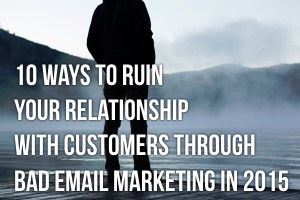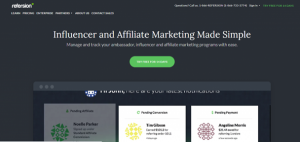
There’s a common opinion circulating around in the business world that there are significantly more ways to fail at something than there are to succeed. And it’s hard to disagree with such a statement. I mean, there’s just so many things that can go wrong when you’re a small business owner.
For instance, your customers can go to the competition, your website – the one where you’re selling your products – can go down, your suppliers can fail you, and so on and so forth.
And if that wasn’t enough, there’s also email marketing and the issues connected with it.
Here’s what I mean. In theory, email marketing is a great method for businesses (SMBs, solo-companies, large firms, and everyone in between) to reach out to their customer base and maintain some form of a relationship. While this is all true, it’s much easier said than done and there are many failure points you can come across as you’re experimenting with various email marketing techniques.
So today, since it’s nearly the end of the year, let’s go through the 10 most common mistakes that lead to ruining your relationship with customers and clients. In other words, do whatever you can to save yourself from the following.
1. Really, really poor email designs
Failing to use good design for individual email newsletters is one of the most common mistakes and probably the oldest one in the book. Design is incredibly important in the today’s business world. Your customers pay attention to what sort of image your brand associates with and what visual images you’re using to convey your marketing messages.
Bad design simply looks unprofessional, and even if the product you’re offering (or service) is top notch, customers will start having second thoughts on whether to work with you or not purely based on the (low) visual quality of your email messages / newsletters.
How to solve this? Spend a while to develop a truly interesting template. Or, go for minimalism (use just your logo and good typography).
2. Not using a quality email newsletter service
This mistake is mostly done by small businesses that are very new to the email marketing game. But it’s still very much out there.
The fact is that sending out emails by hand – through Gmail, for example – is very unproductive and even dangerous for your email account. After a while, the email server that you’re sending your messages from might get flagged for spam or put on a blacklist of some kind for any other reason. This just happens over time, no matter if you send spam or not. As a result, your emails might stop getting delivered altogether. Purely because of the server being on a blacklist.
The best way to save yourself from this is to sign up for a quality email newsletter service. If you’re looking for a free solution, check out SendinBlue or MailChimp. Both provide very good service and all the functionality you’d need. What makes SendinBlue a potentially better choice is that as part of their free plan they also offer autoresponders (something we’ll discuss in just a minute).
3. Not taking advantage of the season
Right now, we’re in the middle of the holiday season (or the New Year’s season). This part of the year is great for running specialized promotions and letting your customers know about them through email marketing.
Each year this scenario repeats itself, and to capitalize on it, you just need to be ready with specific and related promotions that are scheduled to go out on given dates. Your email marketing service will allow you to schedule multiple messages in a row, so it’s not a difficult task from a technical point of view.
4. Not using calls to action
No matter what sort of email newsletter you’re sending, you should always conclude each message with a good call to action – in other words, let your subscribers know what they should do next.
If you’re promoting something specific then this is quite easy – you just ask them to check the thing out on your website. But even if you’re not promoting anything, you should still ask them to share your message on social media, or do whatever else that your business can benefit from.
If you fail to do so, you’re not taking full advantage of the attention that the subscriber has given you by reading your email.
5. Sending out only promotional emails
This is probably the biggest mistake you can make with email marketing. While it is true that you naturally want to use emails to promote your products or services, you can’t be trying to do so with every single message.
Your subscribers will see through this and after a while, they will stop paying attention to your messages altogether. To save yourself from this, make sure to send at least a couple of content-heavy newsletters (like a link to your new blog post or article) for every promotional one.
6. Making it hard to buy
It’s no mystery that people have rather short attention spans online.
Actually, it’s worse than that. A recent study indicates that our average attention span is now shorter than goldfish (for humans it’s eight seconds; for goldfish, nine). This means that we really need to step our game up and try to capitalize on this short period of time by making things as easy as possible for the subscriber.
For instance, if you’re promoting a certain product you have in store, link directly to its page in your Shopify (or whatever other solution you’re using to run your online store). This way you can skip any unnecessary steps and make it possible for the customer to buy the thing with one click.
7. Sending emails too often
This does depend on the market you’re in, but I wouldn’t advise to email your subscribers more than a couple of times every week.
In general, people are not very fond of email, so the last thing you want to do is keep annoying them by sending your messages daily. A customer that’s annoyed will never buy anything.
8. Not giving them a reason to subscribe
If you’re just using a simple subscription form saying something like, “Subscribe to our newsletter here” and nothing except that then you’re doing it wrong. No matter how familiar your customers are with your brand, you need to give them a direct reason to subscribe.
For instance, you can create a resource that answers one of the common problems that the average customer is having, or simply let them know that when they subscribe, they will receive an exclusive 20% off bonus (or something similar).
Whatever it is, there needs to be a direct and understandable reason why someone would want to subscribe.
9. Not using autoresponders
An autoresponder is a kind of a message that goes out on autopilot based on the number of days that the person has been subscribed to your newsletter.
It’s no mystery that every subscriber is the most receptive to whatever you want to share with them right after they make the decision to subscribe. You should capitalize on this short window of opportunity and try building a relationship with the subscriber then.
You can do this via an autoresponder sequence. Set up three or four messages to be sent out on day one, three, and five after a person subscribes. Introduce them to your brand, share your best content, point them to your best promotions.
10. Failing to respond
Every once in a while, people will respond to the messages you’re sending them. They’ll simply click the “respond” button in their Gmail and write you something. Maybe it’s a question, or some feedback. No matter what it is, you need to respond to their messages.
There’s a very good reason why. Up to that point, the communication was done in just one direction – you sending stuff to them. But now, as they are reaching out back to you, you get a unique opportunity to make a personal connection and effectively make the relationship mutual.
11. ?
Doing email marketing effectively can surely be a tough task, and it requires a lot of trial and error before you begin getting a grasp on how it should be done. Mistakes are inevitable. But the important thing here is to keep going, keep experimenting, and in the end, results will follow.
By the way, do you want to add #11 to this list? Ideas?
Digital & Social Articles on Business 2 Community
(311)








